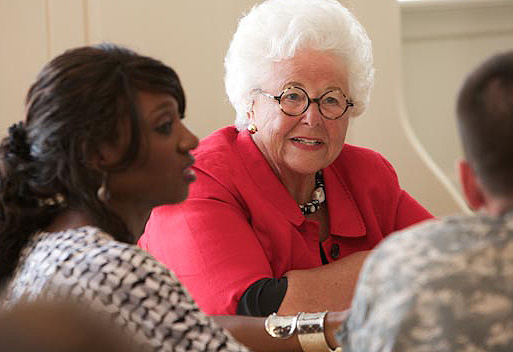In the bucolic setting of Morven Farm, nearly 70 new faculty members learned about becoming part of the University of Virginia community and creating an academic community in the classroom at a three-day orientation this week.
Hosted by the Vice Provost for Faculty Development and the Teaching Resource Center, the Morven orientation included talks and workshops about teaching, career advice and human resources. The orientation wrapped up with a tour of Morven and a trip to Carr's Hill for a welcoming reception hosted by President Teresa A. Sullivan.
The new hires are being counted on to offset a long-expected wave of retirements of Baby Boomer senior faculty, many of whom helped build the University's stellar national reputation.
"Although the numbers are still being finalized, there are up to 180 new teaching, research and professional faculty members this year," said Margaret Harden, an assistant to the vice provosts for faculty development and for faculty recruitment and retention. The numbers of women and underrepresented minorities seem to be increasing in some areas, she said.
U.Va. Provost John Simon has been involved in the overall hiring process and has reached out to deans and department chairs, working more closely with them in being strategic about hiring and cultivating candidates, Gertrude Fraser, vice provost for faculty recruitment and retention, said.
"We've been in retrenchment the past four to five years with hiring restrictions, and then for good reason, some faculty who could retire decided to wait," she said.
Fraser's office has been collecting data on hiring over the past decade. Last year the hiring numbers began to rise from a recent low of 140 new faculty hired in tenure-track jobs in 2009, and the trend is continuing, coupled with an increase in senior faculty retirements. For example, Fraser said the College of Arts & Sciences filled about 16 positions in 2010-11; for 2013, the College will conduct about 23 searches.
The 2011-12 academic year was the first in a decade that U.Va. saw a statistically significant uptick in retirements, Harden added. In 2009, 33 professors retired, compared to 58 this year.
Since 1985, the tenure-track faculty population at U.Va. has been steadily aging. In 1985, 21 percent of U.Va.'s faculty was over age 55. In the fall of 2011, this percentage had climbed to 43 percent, with just 16 percent under 40.
The new faculty members are more than just numbers, though – they want to feel valued, Fraser said. The academic job market has not expanded for several years; where candidates in 2007 said they had five or six job offers, now they say it's one or two, she said.
One luncheon panel featured four U.Va. professors who have been on the faculty for at least five years recounting what they wish they'd known in their first year. They echoed Fraser's comment, reminding new faculty that no matter how overwhelmed they might feel, a lot of U.Va. people wanted them to come here, so it's important to get to know their colleagues.
"Be open to the good will of other faculty," said Ira Bashkow, an associate professor of anthropology in the College, "and don't think of them as competition."
"Relationships matter," said Silvia Blemker, associate professor of biomedical engineering and mechanical and aerospace engineering in the School of Engineering and Applied Science. "Think about the career you are building and the people who are important in helping you." Don't be afraid to ask questions, even if they seem silly, she said.
At the orientation, the new professors had the chance to meet their peers in other departments and be exposed to a wealth of teaching advice from their U.Va. colleagues and the Teaching Resource Center.
Osman Ozbulut, who's joining the Engineering School's civil and environmental engineering department, said he found the teaching ideas helpful, and that he'll try applying them to his classes.
Carrie Bramlett, who started teaching required Spanish courses in the College last spring, said she wants to diversify her teaching with some of the new techniques she learned about, such as collaborative learning.
New in the College's history department, European history scholar Erin Lambert said she appreciated hearing what is emphasized in teaching at U.Va. in workshops about motivating students and making the classroom more interactive.
For Hoitung "Terry" Leung, who will teach in the College's chemistry department, the workshops confirmed what he believes about teaching, he said – the importance of seeking to understand one's students and finding the best ways to communicate with them.
The many young faces at the orientation will be changing the picture of the University faculty in the years to come.
Media Contact
Article Information
August 24, 2012
/content/new-and-settled-faculty-share-collegiality-orientation

